Farm Life
Information and anecdotes about living on a farm
-
Puppy Love! Favorite Dog Quotes

Puppy love is blatantly apparent everywhere in the Monterey area. Back in the Midwest, where I am from originally, dogs are treated like, well, dogs. You see them in dog parks, or walking on trails with their humans, or occasionally you will see a service dog in a traditionally “humans only” place. In Monterey County, dogs are treated a little differently. When I first moved here, I remember walking through the Whole Foods Store in Monterey and being shocked when suddenly a Pomeranian poked its head out of a handbag held by the lady standing in front of me. Far from being excluded from human gathering places, dogs are instead embraced and treated like family.

From Doris Day’s Cypress Inn in Carmel-by-the-Sea to Wine Tasting Rooms in Carmel Valley Village, to beaches, stores, and more, dogs are EVERYWHERE here. Stores place dog water bowls outside their doors for parched pooches. There is even a psychologist in Carmel for those dogs who need canine counseling. If you come to Monterey County, you will soon grow accustomed to, and enjoy encountering a bevy of breeds and their owners in nearly every setting.

I will never forget that day. I was ten years old, and I had brought a puppy home. My father was telling me that I could not keep the puppy. I grew up in a home where dogs were not wanted. I cried, and cried, and cried. My heart was shattered. Flash forward twenty plus years, and as an adult, I had a new puppy, a beautiful Scottish terrier named Ally. Then I added a West Highland terrier named Emma.

My son Nick with Ally and Emma. Ally & Emma drove with me across six states to our new home in California. They were able to see the ocean and play on the beach. They were able to run around on the farm and play with all the other animals. I am glad they lived out their lives to ages 13 and 14 and were able to experience a beautiful climate where they could be outdoors year round.
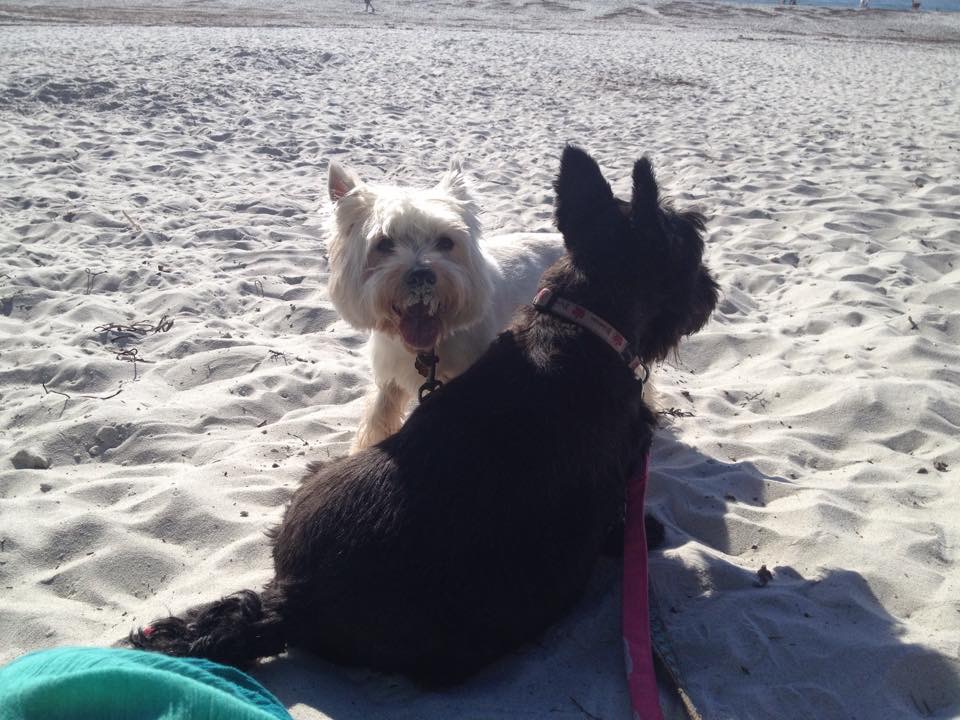
Ally & Emma at the beach in Carmel for the very first time! I then adopted a German Shepherd puppy named Sasha.

Sasha became my best friend and enjoyed her job guarding the farm and antagonizing the goats and chickens.
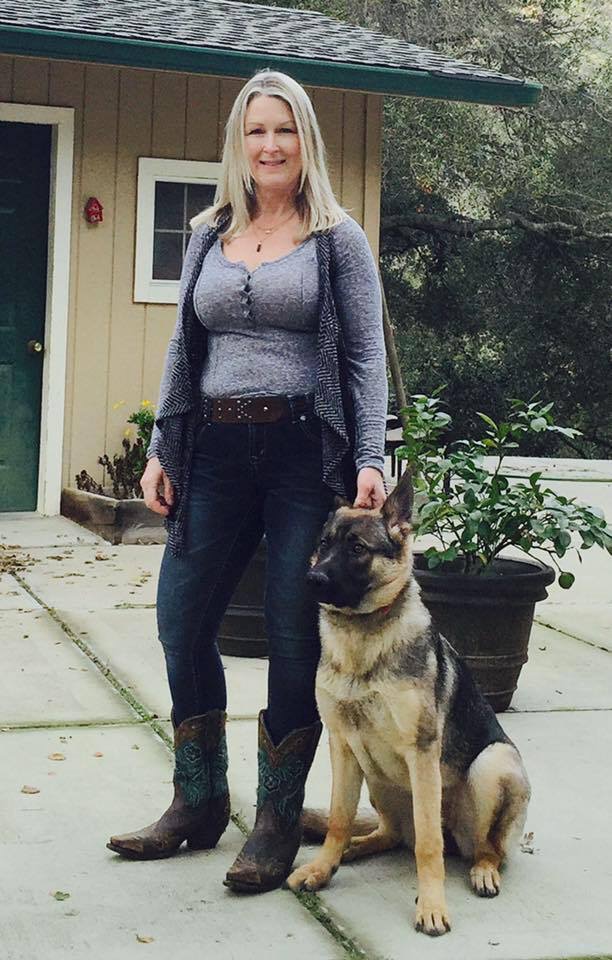
Because dogs are so beloved I thought it would be fun to put some dog quotes together for my blog. I hope you enjoy them.


“A dog is the only thing on earth that loves you more than he loves himself.”~Josh Billings

Puppy kisses with my son’s dog “Swisher”. 
“Home is where the dog runs to greet you.”~Unknown




“A dog is the only thing on earth that loves you more than he loves himself.”~Josh Billings


“There is nothing truer in this world than the love of a good dog.”~Will Rogers


“Dogs have a way of finding the people who need them, and filling an emptiness we didn’t ever know we had.” ~Thom Jones
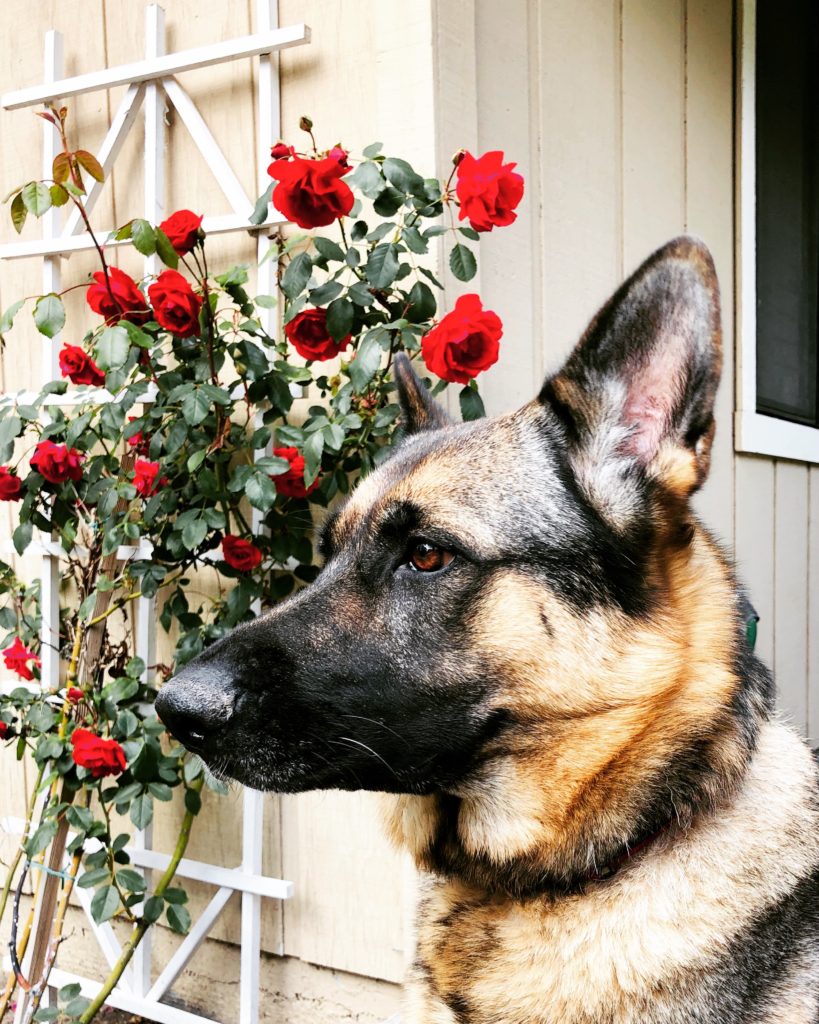

I am going to end this with a beautiful quote that my friend provided. “I will never move and not take you with me. I will never put you in a shelter and leave. I will never let you starve. I will never let you hurt. I will never desert you when you get old, nor will I leave you when you go blind. If that time comes, I will be there to hold you. Because I love you, and you are FAMILY.” ~unknown. This, dear hearts, is true puppy love.

I hope you enjoyed my dog quotes. Wishing you peace, love, happiness, & warm puppy snuggles.
-
The Bluebird of Happiness, Nature’s Inspiration

As I walked with my dog, Sasha, down the road near our home deep in a California canyon, I spotted a bluebird. He was almost impossible not to see, with his brilliant blue back, and flame orange belly. As we continued to walk forward, he flitted from fencepost to fencepost, as if guiding us along. I knew it was a male, as female bluebirds have duller colors than males, much like many other birds. I felt a sense of exhilaration and happiness, just seeing this beautiful bird.

Why does the bluebird bring us such joy? It has been known as the bluebird of happiness for thousands of years around the world, beginning in China, where it was seen as immortal, a protector, and a symbol of the sun. Native Americans revered the bluebird. Navajos saw it as a spirit in animal form and the Iroquois believed the bluebird’s song would chase away the spirit of winter. In Russian fairy tales, the bluebird represented hope. In 1908, a play named “The Blue Bird” by Maurice Maeterlinck depicted two children in search of the Bluebird of Happiness. This play was adapted into an opera, several films and a children’s novel.

Historically, the bluebird has appeared in everything from artwork to advertisements. 
Bluebirds are often known as the harbinger of spring. Early American pioneers called them “blue robins” because of their bright orange breast and iridescent blue back and tail. Bluebirds are also hailed by gardeners because of their appetite for plant damaging insect pests.

In 1934, around the time my grandmother was being courted by my grandfather, the song “Bluebird of Happiness” was recorded. Composed by Sandor Harmati with words by Edward Heyman, by 1945 it had become a world wide hit.

My Grandmother and Grandfather, circa 1934. 
“So be like I, hold your head up high, till you find a bluebird of happiness. You will find greater peace of mind knowing there’s a bluebird of happiness. And when he sings to you, though you’re deep in blue, you will see a ray of light creep through. And so remember this, life is no abyss, somewhere there’s a bluebird of happiness.”
Many other bluebird songs followed, including Judy Garland’s “Hello, Bluebird” and Paul McCartney’s “Bluebird”. And who can forget the iconic song from the Wizard of Oz, “Over the Rainbow”, where “bluebirds fly…if happy little bluebirds fly beyond the rainbow, why, oh why can’t I?”

Judy Garland memorialized the bluebird for all time in her classic song from “Wizard of Oz”. The bluebird is the state bird of Missouri, and did you know that in the United States, there is even a National Bluebird of Happiness Day? It falls on September 24.

Bluebird days are used to describe a sunny day following a storm. In the ski and snowboard world, bluebird days refer to days with sunshine, good visibility, and fresh snow.

Bluebirds are loved for their beauty, family devotion, and delightful song. If you would like to learn more about bluebirds, see national bluebird society.
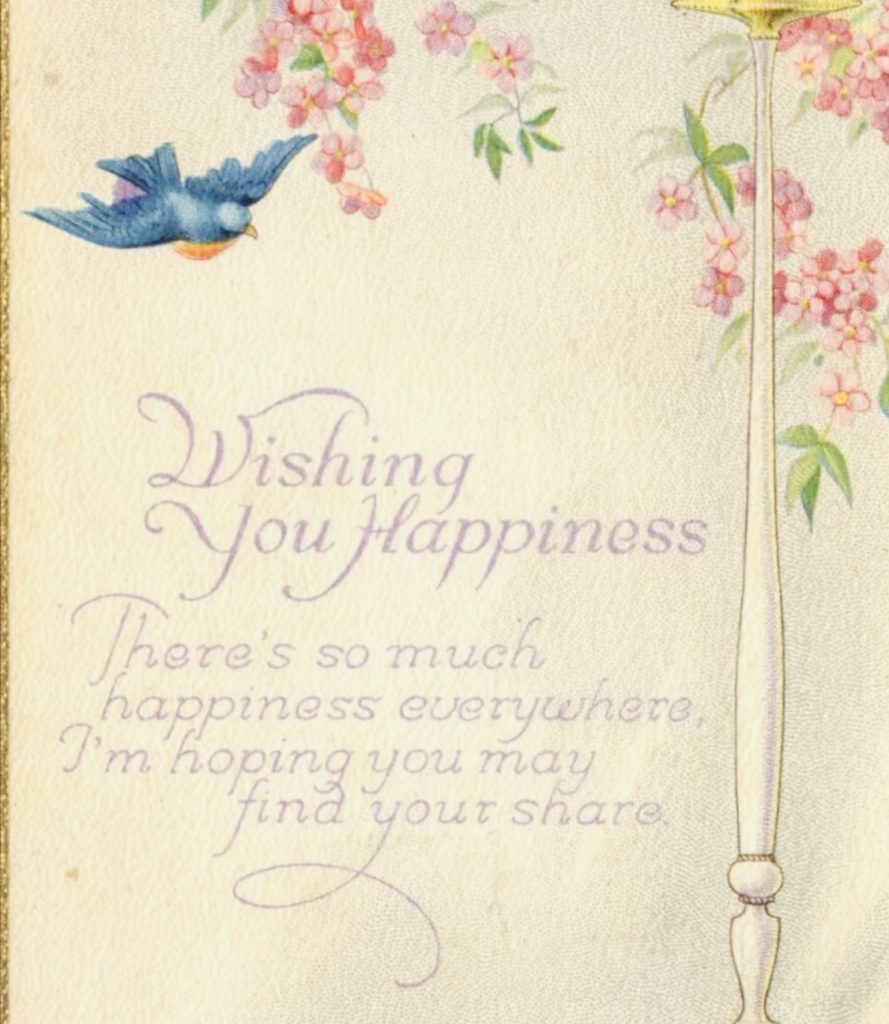
All good things must come to an end. Much to my dismay, our bluebird guide eventually flew away, but he left me feeling very happy. Seeing him made me feel that Spring is on the way! I hope that like me, you find inspiration from the bluebird. Wishing you peace, love, joy, and beautiful vistas.
-
Rabbit Romance: My Love Affair With Bunnies

Easter and springtime bring to mind baby chicks, eggs, and of course, bunnies. With their twitchy little noses, fluffy tails, and long, soft ears, rabbits are simply adorable. I have always loved them.

I grew up in a home where my father did not care for pets. Dad had already nixed my request for a kitten or puppy. It was only due to my Mom surreptitiously sneaking him into the backyard along with his rabbit hutch that I came to know and love Oliver. Oliver was a very fat, sweet rabbit, as brown as a bread crust and with feet as big as my hands. When Dad discovered my new pet, he was told that Oliver’s previous owner had departed for college and could no longer care for him. There was no taking him back. Wink wink.

My bunny Oliver. Oliver became my best friend. I would dress him up in baby doll bonnets and Daisy Duke cut-offs, feed him lettuce and carrots, and snuggle with him. I would ride around with him tucked safely inside a white flower-power basket on the front of my bicycle, which often drew astonished looks from folks we passed in the neighborhood.

My love of rabbits only grew with my love of reading about them. Beatrix Potter’s Tale of Peter Rabbit was a favorite of mine. I ended up naming one of my sons Peter; it may have been my adoration for Peter Rabbit. I loved that Peter Rabbit was the naughty one in the family, sneaking into Mr. McGregor’s garden and binging on veggies. After his misadventures, his siblings, Flopsy, Mopsy, and Cottontail get fresh bread and blackberry jam but poor Peter gets only chamomile tea and is put to bed. Poor Peter!

Brer Rabbit, created by Joel Chandler Harris, lived in a briar patch and was always one-upping the naughty Brer Fox. I have always admired him because he was resourceful and survived by his wits to escape capture. He was a tricky trickster!

The Velveteen Rabbit, by Margery Williams, is a dear and lovely book I am besotted with. Is there anyone that does not love this classic quote?


Thumper, the bunny in Bambi always reminded me “If you can’t say something nice, don’t say anything at all.” A good life lesson that I need to abide by.

The White Rabbit in Alice and Wonderland always fascinated me, running around helter-skelter with his pocket watch. There was also the March hare who was obsessed with having tea. Never a dull moment for the bunnies in Wonderland!

The Country Bunny and the Little Gold Shoes by Dubose Heyward tempted me with the most magical fairy tale adventures.

Do you have any favorite rabbits or rabbit stories? If so, I would love to hear about them. Thank you for visiting my blog. Wishing you peace, love, happiness, and a beautiful Easter!
-
Corral de Tierra, The Pastures of Heaven
 Heaven is under our feet as well as over our heads–Henry David Thoreau.
Heaven is under our feet as well as over our heads–Henry David Thoreau.Corral de Tierra is a pastoral area of verdant meadows and remote canyons situated midway between Salinas and Monterey. It is notable for the innumerable California live oaks that flourish here. It is considered to be in the “sun belt” so that even if it is foggy and gray in nearby Salinas and Monterey, the sun is usually shining here. The area comprises many small communities including Serra Village, Toro Park Estates, San Benancio, The Villas, The Meadows, Markham Estates, Corral de Tierra Country Club, Laureles Grade, Chamisal, Vista Dorada, and Laguna Seca Estates, as well as myriad vineyards, farms and ranches. It is named for the Mexican rancheros who used a canyon in the upper valley during the 1700s to hold their cattle. Corral de Tierra literally means “fence of earth”.


Underwood Canyon in Corral de Tierra is breathtaking in the spring. Corral de Tierra’s transformation from a vast wilderness to a settlement begins with a love story. In 1836, Governor Nicolas Gutierrez granted over four thousand acres in the area to Francisco Figueroa in exchange for the hand of his daughter Guadalupe. I picture the story unfolding with Guadalupe, leaning out of the window of a beautiful Spanish style home. She is wearing an exquisite lace dress, has beautiful flowing black hair, and is holding a crimson rose that the dark and handsome Nicolas has given her just before he rides off into the sunset on a meticulously groomed stallion. We will never truly know how this love story played out. Following the Mexican-American War, California was ceded to the United States and homesteads began to spring up as a series of new owners bought and sold land here.

The De Tierra Vineyard & Winery is located in Corral de Tierra. Growth was slow in the area until the 1950s, when the Corral de Tierra Country Club was built. In the 1960s, the Chamisal Country Club was established. There were originally two schools in the area: Washington Elementary School at mid-valley was established in 1873 and is still going strong today. Lincoln School, built in 1887, was located at the intersection of Underwood and Corral de Tierra, but no longer exists. San Benancio Middle School is a newer school located at the corner of San Benancio and Hwy 68. There are two churches in the area: Good Shepherd Episcopal Church and Cypress Community Church. The clubs, schools, and churches here provide a sense of connection and an avenue for social events within the community.

Turkey vultures, bobcats, magpies, deer, wild turkeys and quail are frequently seen here. John Steinbeck, the famous author, often stayed with his maternal aunt in Corral de Tierra. She lived on a farm near the present day Markham Ranch. Steinbeck was not only a prolific writer, but also an avid reader, and loved the tales of King Arthur and the Knights of the Round Table. He enjoyed exploring the rugged sandstone bluffs of Castle Rock in Corral de Tierra, near his aunt’s farm, and imagined the area as the citadel of Camelot. While the public cannot access Castle Rock, located within Markham Ranch, it is clearly visible from Corral de Tierra Road.

A rainbow seen from my farm. Steinbeck’s experiences in Corral de Tierra were the catalyst for a collection of stories presented in his novel “The Pastures of Heaven.” In this novel, a Spanish Corporal discovers the area while chasing runaway Native American slaves that have abandoned their work building a Catholic mission. When he arrives at a ridge and sees a breathtaking view of the fertile valley below, he is smitten and christens the valley “Las Pasturas del Cielo” or “The Pastures of Heaven.” From that time on, he plans on returning to the beautiful valley, but his hopes are never realized. Steinbeck’s work was based on a real Spanish Corporal who did, in fact, discover the area in 1776 while pursuing Rumsen Indians who had escaped from the San Carlos Mission in Carmel.

Castle Rock, Steinbeck’s childhood playground, is located in Markham Ranch. Fun activities in Corral de Tierra include biking, hiking, swimming, golfing, tennis, horseback riding, and birdwatching. It is also a great place for astronomers: with a clear night sky far away from city lights, nearly every constellation is visible. Corral de Tierra is also a popular area for plein air artists. Plein air began in France in the 1890s as a movement seeking to create art in outdoor settings in natural light and weather conditions.

Living near so many ranches means seeing cattle and horses every day! What I love most about living in Corral de Tierra is the peacefulness and the sense of community. There is a genuine and authentic calmness and simplicity here. Neighbors are like family. I adore mine and am eternally grateful for them. No matter what happens in life, or where I end up, I will always thank my lucky stars for the beautiful and amazing experience I’ve had in the Pastures of Heaven.

Goats, chickens and sunshine = happiness. Thank you for visiting my blog! Wishing you peace, love, happiness & beautiful vistas!

Sasha loves life in Corral de Tierra. -
15 Things You Should Avoid Feeding Your Chickens
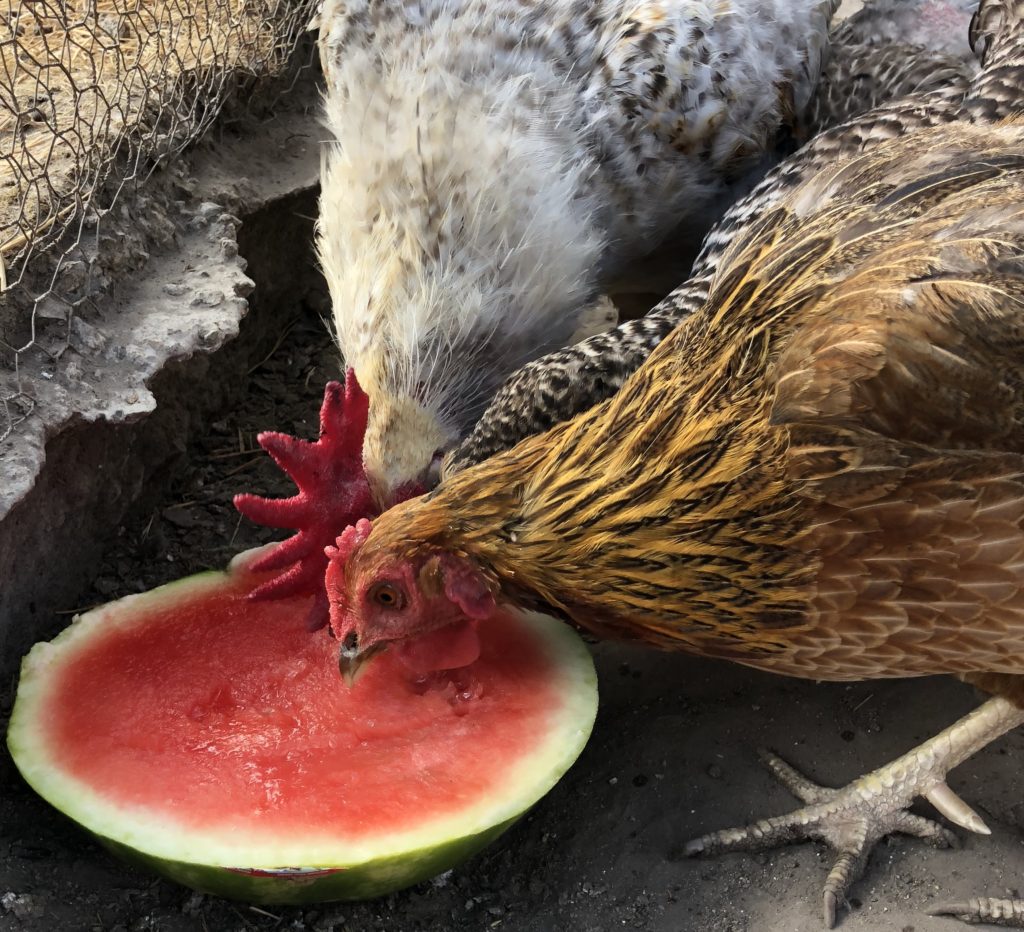 There is nothing more adorable than watching a hen waddling as fast as she can toward you in anticipation of getting a treat. Her little legs moving as fast as she can, her eyes full of excitement. Giving treats to chickens is indeed a fun experience, but it is good to know which treats are bad for your feathered friends. While most fresh fruits and vegetables are fine to feed your flock, the following is a list of treats you want to avoid.
There is nothing more adorable than watching a hen waddling as fast as she can toward you in anticipation of getting a treat. Her little legs moving as fast as she can, her eyes full of excitement. Giving treats to chickens is indeed a fun experience, but it is good to know which treats are bad for your feathered friends. While most fresh fruits and vegetables are fine to feed your flock, the following is a list of treats you want to avoid.Do NOT feed chickens the following, as they can be TOXIC:
- Apple seeds. If you are going to give your chickens apples, make sure to first remove the seeds, as they contain amygdalin, a substance that releases cyanide into the bloodstream when digested.
- Green or sprouted white potatoes. They contain a toxin called solanine, which affects the nervous system (it’s bad for both birds and people). Sweet potatoes are fine to feed chickens!
- Avocados. The pits and skins contain the toxin persin, which can be fatal to chickens. The fleshy part is safe to give them in moderation.
- Chocolate. Chocolate contains theobromine, which is toxic to birds and many other pets.
- Uncooked beans, rice or legumes. Uncooked beans contain a toxin called hemaglutin which is dangerous to chickens. Cooking the beans before serving them to the chickens is ok as this kills the toxin.
- Raw eggs. Your chickens may enjoy the taste of raw eggs so much they will eat them from their nesting boxes. It is best to either scramble or boil eggs before feeding them to your flock prevent this.
- Onions, chives, and garlic. These affect the flavor of your hen’s eggs and can contribute to the development of Heinz Anemia.
- Rhubarb. Rhubarb contains oxalic acid, which can cause calcium deficiency. Prolonged exposure can lead to kidney failure.
- Really salty foods. Some salt is okay, but too much can be deadly.
- Moldy food. Never feed any foods that are moldy or rotten. If you wouldn’t eat it, they shouldn’t eat it either.
- Raw meat. Never, ever feed your poultry raw meat. It can carry parasites and diseases. It may also lead to aggressive behavior and cannibalism in your flock.
- Dairy. Chickens aren’t able to digest lactose, but if you want to give small amounts of yogurt, it’s ok. Just know that dairy can cause diarrhea. A good substitute for dairy would be oyster shells.
- Grass clipping and pulled weeds. Never provide this to your chickens as it can lead to an impacted crop. It’s best to let them forage for themselves.
- Raw peanuts. Feeding chickens these legumes is a big NO. They contain a trypsin inhibitor (trypsin is an enzyme that the pancreas makes to help the intestines absorb protein) and can be deadly.
- Eggplant peelings. The flesh is ok, but the peels contain solanine which is toxic.
My chickens prefer the following treats: strawberries, cantaloupe, watermelon, grapes, lettuce, kale, Swiss chard, and broccoli. Let me know what treats your chickens enjoy! Thank you for visiting my blog. You may also enjoy Hen House Inspiration: The 20 Cutest Chicken Coops Ever! and Common Chicken Sayings. Wishing you peace, love, joy, and happy chickens!
-
Hen House Inspiration: The 20 Cutest Chicken Coops Ever!

- The Versailles-inspired Coop. Offered by Nieman Marcus for a mere $100,000.00, this posh abode contains multiple levels, including a nesting area, a living room for nighttime roosting, a broody room, “a library filled with chicken and gardening books for visitors of the human kind”, and last, but not least, an elegant chandelier.
.

2. The Little Red Barn by GopherBoy Farms. This was built entirely from junk, scraps, and odds and ends. I would say he did a pretty good job, and I bet his chickens would agree.

3. A chicken tractor from My Chicken Home would entice even the fussiest hen. A chicken tractor is basically a chicken coop that has wheels so that you can transport the coop to various areas on your property. It will also protect your chickens from being harmed by predators.

4. This turquoise trimmed coop was pieced together with “salvaged and repurposed” materials. Source: Good Enough.

5. This darling coop by Crafty Farm Girl began life as a playhouse. Super cute!

6. Holier-than-thou chickens need their own church coop! This coop was originally posted on Craigslist in the Seattle area, and for some lucky poultry, their prayers must have been answered.

7. This rustic coop from freecycleusa.com is made of recycled materials. Love the cute little weather vane!

8. A Tree Trunk Chicken Coop. For real? This is in an industrial park in New York. Source: Flickr

9. This tiny teal coop from England can house up to three chickens and is adorable! Source: Oakdene Designs.

10. A medieval looking stone coop looks like something out of Game of Thrones! Source: Kalla.

11. Chickens like Christmas Cheer too. This owner decorates her beautiful walk-in coop with wreaths for the holidays. Souce: happydaysfarm.

12. This kooky coop reminds me of Pippi Longstocking or Baba Yaga. Definitely one-of-a-kind! Source: roseapples.tumblr.com.

13. Victorian Charm is in the details with this carefully constructed coop by The Bird House.

14. All aboard the chicken express! Another tractor, this one is ready to chug down the train tracks. Source: thepoultryguide.com

15. This mint green coop (countryliving.com) is so darling it looks like a doll house.

16. This whimsical Coca-Cola and tin coop from montanahappy.com is perfectly petite and adorable.

17. An old chest of drawers has been repurposed into a diminutive coop


18. Old vehicles can also be transformed into coops. The “cluck bus”, from Community Chickens is home to more than a handful of hens! This old car (source: alternet.org) has also been converted.

19. This quaint coop is plain and simple. From Homestead Revival.
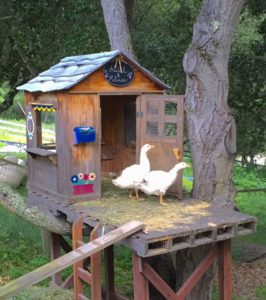
20. I initially converted this treehouse into a home for my two geese, Abelard and Heloise, but have since turned it over to two of my chickens.
Wishing you peace, love, & happiness!
-
Fairy Eggs! Tiny Surprises from your Chickens
 Fairy eggs, also called “wind”, “witch”, “cock” or “fart” eggs, are much smaller than regular eggs and usually contain no yolk. They are the result of a common glitch in the laying process. Fairy eggs often occur very early in a hen’s productive life before her hormones and reproductive cycle are working properly. Sometimes, however, they may occur very late in a hen’s laying life as her hormone production is winding down. They can also be the result of stress, a new diet, new flockmates, environmental changes, or a disruption of routine.Fairy eggs come in all the colors that hens lay: white, brown, green, blue, pink, and beige. Sometimes they may be lighter or darker than regular eggs since they may spend more or less time in the hen’s shell gland pouch. This deposits pigments in the final stage of egg making. Fairy eggs are nothing to be concerned about and are fine for humans to eat.
Fairy eggs, also called “wind”, “witch”, “cock” or “fart” eggs, are much smaller than regular eggs and usually contain no yolk. They are the result of a common glitch in the laying process. Fairy eggs often occur very early in a hen’s productive life before her hormones and reproductive cycle are working properly. Sometimes, however, they may occur very late in a hen’s laying life as her hormone production is winding down. They can also be the result of stress, a new diet, new flockmates, environmental changes, or a disruption of routine.Fairy eggs come in all the colors that hens lay: white, brown, green, blue, pink, and beige. Sometimes they may be lighter or darker than regular eggs since they may spend more or less time in the hen’s shell gland pouch. This deposits pigments in the final stage of egg making. Fairy eggs are nothing to be concerned about and are fine for humans to eat. While I find the nickname “fairy eggs” to be quite endearing, these miniature eggs have had several names through the ages. In the Middle Ages, they were called “cock” eggs, since, without a yolk, the egg wasn’t viable, and was believed to be laid by roosters. They were also referred to as “witch” eggs, which were believed to be the work of the devil. According to superstition, to protect against the evils of a cock egg, one should throw it over the roof of the family house and let it smash on the ground on the other side. In Scotland and other European countries, the eggs are referred to as “wind” eggs. More recently in the US, they have been labeled with the indelicate moniker “fart” eggs.Sometimes, we need to believe in fairy tales. And fairy eggs. It’s the little things in life, after all!
While I find the nickname “fairy eggs” to be quite endearing, these miniature eggs have had several names through the ages. In the Middle Ages, they were called “cock” eggs, since, without a yolk, the egg wasn’t viable, and was believed to be laid by roosters. They were also referred to as “witch” eggs, which were believed to be the work of the devil. According to superstition, to protect against the evils of a cock egg, one should throw it over the roof of the family house and let it smash on the ground on the other side. In Scotland and other European countries, the eggs are referred to as “wind” eggs. More recently in the US, they have been labeled with the indelicate moniker “fart” eggs.Sometimes, we need to believe in fairy tales. And fairy eggs. It’s the little things in life, after all! -
Common Chicken Sayings

It is amazing to me that so many everyday sayings refer to chickens. The following is a list of phrases referencing chickens.
Be chicken- to be afraid
Nest egg – to save a little money each week
Scratching out a living – to earn enough to get by on
Don’t count your chickens before they hatch – don’t plan on something before it actually happens.
Don’t put all your eggs in one basket – don’t plan on an outcome before it actually happens.
Chicken feed – small amount of money
Feather your nest – saving for the future
Hen house – large number of females living in the same house
Mother hen – very protective
Madder than a wet hen – very angry
Fussing like an old hen – angry
Scarce as hen’s teeth – extremely hard to find
Chick – a woman
Hen-pecked – nagged
The rooster may crow but the hen delivers the eggs
Rooster games – willing to fight instead of trying to work out a problem
Flew the coop – gone
Up with the chickens – waking early with the sunrise
Walking on eggshells- treading softly where certain people are concerned; trying not to upset someone
Like a chicken with it’s head cut off – running around with no direction
Shake a tail feather – get moving
Strutting’ your stuff – Showing off
Bird brain – senseless
Dumb cluck – senseless
Ruffle your feathers – something annoys you
Chicken hearted – Not brave
No spring chicken – An old person
Hatch an idea – put a plan into motion
Egg on your face – caught in an untruth
Rule the Roost – to be the boss
Pecking order – hierarchy, your rank
Play Chicken – a stand off, who will give first
Brood over it – to worry over a problem
Chicken scratch – poor handwriting
Bad egg – less than honest person; poor moral standards
You have to break eggs to make an omelet – sometimes you need to make a mess to get something done
It’s not what it’s cracked up to be – disillusionment
I hope you enjoyed this! Happy Tuesday!
-
A Single Ember: Soberanes & California Wildfires

Living in California involves a delicate dance between nature and man. The high drought of summer contrasts with the lush rainy season of winter. One can become complacent, expect things to go on just as perfectly as ever in this coastal paradise, never realizing that one small spark can lead to such horrible consequences. California wildfires are becoming bigger and more devastating, and there cannot be too much education regarding prevention, in my opinion. There is a new ad campaign out with the message “A single ember can travel over a mile”, and I seriously hope people think about this.
The year I moved to my farm there was a fire in north Corral de Tierra, supposedly caused by a trailer dragging chains along the highway, which created a series of sparks jumping alongside the dead grass ditches and transmogrifying into a pitched wildfire. There was also another fire to the south in Tassajara set by a purportedly suicidal man who set himself on fire in his car, initiating a wildfire which burned uncontrollably for weeks. Last year I journaled my experience during the devastating 2016 Soberanes fire.
—I see a faint flicker of difference in the lighting the minute I step outside. The normally blue sky is now somewhat pink as if someone is holding a gargantuan piece of rose colored fabric between the sun and earth. I do not see flames but I soon learn their inauspicious cause. It is coming from Soberanes, an area located south of Monterey and Carmel, with trails snaking through steep hills overlooking the Pacific Ocean along the Big Sur Coastline. Local firefighters as well as those from further north in San Francisco are now battling the fire in this remote and heavily forested area.
Each day I wake to find a smattering of white flakes like a delicate sprinkling of fine snow powdering the tawny hillside. It is ash confetti from the wildfire being blown over in a sobering morning kiss. I see photos of firefighters on the news contrasted with smoke and flame. Their faces are cavernous and hollow. Their eyes are worn, haunted. They look tired of the fighting the flames. They just look done in. By day 10, the fire is approaching Carmel Valley. They say five fire lines have been cut to prevent the fire from reaching the village. That is what they say.
It has now been over two weeks and the fire is moving south. They say it is 50% contained. The firefighters say it was caused by an illegal campfire set at the junction where two meandering creeks met to form a waterfall in the depths of Garapatta forest. At least 57 homes and buildings have been burned up, and a bulldozer operator working to clear brush was killed when his bulldozer topped over on the steep terrain, crushing him beneath. The horrible stench of smoke I have awoken to the past several days is waning, although they say on the news our poor air quality is approaching that of Delhi, India.
Who set the campfire? Stories have been circulating. One involves a group of homeless people from Santa Cruz who were asked to leave by forest rangers but returned later to move even further into the forest. Was it a campfire of revenge? Another story involves the possibility of a couple out for a hike who became enticed by the beauty of the streams and waterfall and stopped for a romantic tryst, hastily lit a campfire, then abandoned it. Stories are stories. Whatever the reason, the effect of their actions is entirely devastating.—
The Soberanes Fire was eventually quelled after three months, and was deemed the most expensive wildfire to fight in United States history. Sadly, most wildfires are caused by PEOPLE. According to CalFire and the Forest Service, the following can cause wildfires: burning debris, smoking, unattended campfires, kids playing with matches, sparks from trains, outdoor equipment such as weed whackers, and the heat from catalytic converters in autos. If you are visiting California, please check with the local authorities before having a campfire. There are often strict penalties for unapproved fires here, and as you can see, for good reason. Peace out!
-
Rare Chickens: Beautiful & Healthy Eggs

When you raise your own chickens, you gain peace of mind knowing exactly where your eggs came from. Organic and free-range eggs contain higher levels of Omega-3 fatty acids, beta carotene, Vitamin E, and Vitamin A. They are also lower in saturated fat and cholesterol than conventional, store-bought eggs.

When I first moved to my farm, raising my own chickens was a priority. I could not wait for my first eggs to arrive. I started out with your average, run-of-the-mill chickens such as Leghorns and Australorps from the local farm supply store, but soon I became fascinated by the more rare, heritage breeds, especially those that laid eggs in novel colors. I now focus on raising the following breeds:

- French Marans. French Marans lay deep chocolate brown colored eggs, that when cracked open reveal a bright orange, yolk, bursting with vitamins, protein, and fats from its healthy lifestyle. Marans have the reputation for laying the best-tasting chicken egg in the world. (Perhaps, for these reasons, the author Ian Fleming identified Marans eggs as those most preferred by James Bond.) I raise ultra-rare Birchen Marans. My Marans are extremely docile and sweet.


2. Swedish Isbars. Swedish Isbars are thrifty foragers that will produce 150-200 green eggs a year. The eggs vary in shade of green from a dark olive to a lighter moss green. Some eggs also have small brown speckles against a green background, and many chicken aficionados think Isbar eggs are the most beautiful of any egg. Whether speckled or pure green, the Isbar eggs are as magical and exotic as the birds themselves. I love that when hatching Isbar eggs, you literally never know what color chicks you will get! They range in color in unique variations of black, grey, and white.


- Cream Legbars. Cream Legbars were first introduced at the London Dairy Show in 1947 and received a written standard by the Poultry Club of Great Britain in 1958. Legbars grew in popularity to fill a niche market in the British egg industry for pastel sky blue eggs produced by free-range birds. Cream Legbars are medium-sized fowl that are known for their active foraging and ability to survive in a free-range environment. The females look like they are wearing little beret hats. I think they are just adorable!
Raising chickens involves some basic dedication: ensuring they have clean water, fresh food, and a clean coop. But the rewards are amazing: fresh eggs, beautiful feathered friends, insect pest control, and last but not least—chicken manure makes great compost for your garden. I highly recommend the keeping of chickens!
- French Marans. French Marans lay deep chocolate brown colored eggs, that when cracked open reveal a bright orange, yolk, bursting with vitamins, protein, and fats from its healthy lifestyle. Marans have the reputation for laying the best-tasting chicken egg in the world. (Perhaps, for these reasons, the author Ian Fleming identified Marans eggs as those most preferred by James Bond.) I raise ultra-rare Birchen Marans. My Marans are extremely docile and sweet.